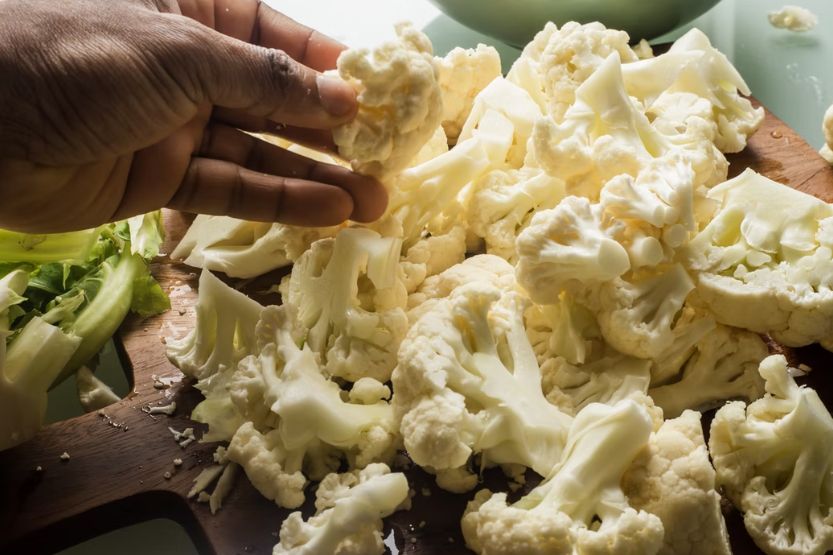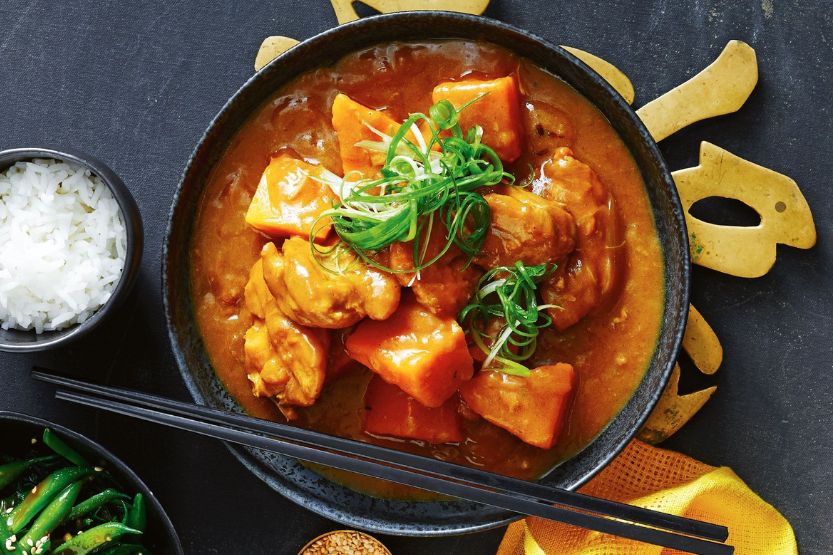You’ll find many variations of traditional Japanese curry recipes, each with its unique twist. However, they all have one thing in common: they’re hearty, satisfying meals that are sure to hit the spot when you’re looking for something comforting! In this article, I’ll focus on Japanese curry using traditional vegetables.
Japanese curry is a staple of Japanese cuisine, but you may wonder what traditional vegetables are used in it. The most commonly used vegetables include carrots, potatoes, and onions. But other vegetables can also be added, including:
- Green beans
- Japanese eggplant
- Kabocha
- Asparagus
- Bell pepper
- Tomato
- Ginger
- Garlic
- Cauliflower
- Corn
- Okra
Read on to learn more about the traditional vegetables used in cooking Japanese Curry and the importance of these veggies to ensure that the dish is flavorful and authentic, including a Japanese curry recipe you can try.
List of Most Common Vegetables in Japanese Curry

When it comes to Japanese curry, there are a few traditional vegetables that you’ll see in almost every dish. You’ll see carrots, potatoes, and onions. This is because they’re the main ingredients in curry roux.
When you buy a box of premade curry roux off the shelf or make it from scratch, these vegetables will be in it. Add your favorite veggies like mushrooms, green beans, or asparagus.
1. Carrots
Carrots are another common component of Japanese curry recipes. While they may not be as popular as potatoes, they’re still integral to any good curry dish.
To prepare carrots for making Japanese curry:
- Wash them thoroughly with cold water until all dirt is removed.
- Peel off any parts you don’t like using a knife or vegetable peeler.
- Add carrots as a whole or shredded into small pieces, depending on your preference.
2. Potatoes
The humble potato is used in many ways in Japanese cooking and is no different in curry. In addition to being the most common ingredient in a bowl of curry, potatoes are often used as garnishes for other dishes.
For potatoes, you can use any variety of potatoes. The important thing is to ensure the potatoes are cooked through and soft before adding them to the curry.
- If you’re using large potatoes, cut the potatoes into cubes, then boil in salt water until they are soft (this only takes about 15 minutes); or
- Add them to your pan like usual if you’re using baby potatoes.
Once they’re ready, strain off any excess liquid and add them to your pan with the curry mix.
3. Onion
There are a few different types of onion that can be used for Japanese curry. However, yellow onion is the most common and easiest to find.
How to prepare onions for Japanese curry?
- Start by peeling the onion and then cutting it in half.
- Next, cut each half of the onion into thin or thick slices.
- Once the onions are sliced, you can sauté them in a pan with oil until it is soft and translucent.
- Add sautéed onions to the curry sauce when ready to cook it.
4. Green Beans
Green beans are another common vegetable used in Japanese curry. They can be added either whole or cut into pieces. I like to add them towards the end of cooking so they retain their crunchiness, but if you prefer softer green beans, feel free to add them at the beginning.
How to prepare green beans for Japanese curry:
- Rinse the green beans and trim off the ends.
- If you’re using whole beans, leave them as is.
- If you’re cutting them into pieces, cut them into 1-inch (2.5 cm) lengths on a diagonal. This makes them look pretty when added to the curry later.
5. Japanese Eggplant
Japanese eggplants are a little smaller than the ones you may be used to seeing, but they’re still packed with flavor. They have a mild flavor with a sweet tinge, which is why they pair well with curry.
The key to getting the most out of your Japanese eggplant for Japanese curry is cleaning and preparing it correctly. Here’s how:
- First, wash the eggplant under running water and cut off any parts that look damaged or bruised.
- Next, cut off both ends of each eggplant. This will help remove any bitterness from inside them.
- Slice your Japanese eggplant into rounds about ¼ inch thick (about 5mm).
6. Kabocha
Kabocha, also known as Japanese pumpkin or kabocha squash, is a hearty vegetable high in beta carotene, making it an excellent source of vitamin A. It can be used for sweet and savory dishes, making a delicious side dish to a Japanese curry recipe.
To clean kabocha:
- Scrub the skin with a brush or soft cloth until clean.
- Cut open and remove seeds from inside using a spoon.
- Cut into small cubes (the size of a quarter) and set aside while you prepare the other vegetables for cooking.
7. Asparagus
It’s pretty common. Asparagus is often used as a garnish or side dish in many Japanese dishes, so it only makes sense that it would find its way into a curry.
It is usually cooked until tender before being added to the pot, and its slightly sweet flavor pairs well with the other curry ingredients.
To prepare asparagus for Japanese curry:
- Rinse thoroughly under cold running water.
- Remove any tough ends using a paring knife.
- Cut off the top inch of each stem at an angle so they look like little trees when served raw or cooked.
- Set it aside until ready to add with other curry ingredients.
8. Bell Pepper
Bell peppers are another great addition to Japanese curry. They add sweetness and fantastic color to the dish, and their slightly crunchy texture pairs well with the other ingredients. Use any bell pepper you like, but red or yellow are sweeter than green ones.
How to prepare bell peppers for Japanese curry:
- Cut the bell peppers into bite-sized pieces.
- Sauté cut bell peppers before adding them to the curry. This makes them more tender and releases some of their sugars, which helps to create a deeper flavor.
9. Tomato
Tomatoes add acidity, sweetness, and a lovely red color to Japanese curry. You can use any tomato you like, but cherry tomatoes work best because they tend to have a higher sugar content and break down quickly when cooked.
To prepare tomatoes for Japanese curry, you need to cut them into small pieces and sauté them before adding them to the curry. This helps release their juices and prevents them from making the dish too watery.
10. Ginger
Ginger adds a bit of zing and freshness to the dish. It pairs well with the other ingredients and helps round out the flavors.
How to prepare ginger for Japanese curry:
- The ginger should be peeled and grated before adding it to the curry.
- You can also use chopped ginger, but I find that grating gives the best flavor.
11. Garlic
Garlic is not used as often as onions in Japanese curry, but it can be a good addition if you like the flavor.
To prepare garlic for Japanese curry:
- First, peel and chop the cloves into small pieces.
- Then, sauté the garlic in a pan with oil until it is soft and fragrant.
- Finally, add the garlic to the curry sauce when ready to cook it.
These are all vegetables that you can add to Japanese curry. You can add one or more of them if you have them on hand or skip them altogether.
Other Vegetables That Work Well with Japanese Curry

1. Cauliflower
Cauliflower is a great way to make a popular Japanese vegan dish version. The cauliflower soaks up all the flavors from the curry, making it just as delicious as its meaty counterpart. Just cut the florets into small pieces so they cook evenly.
2. Corn
Corn works well with Japanese curry. Its sweetness helps balance the curry’s spiciness, making it milder and less hot.
How to prepare:
- You can use frozen sweetcorn or canned corn to make Japanese curry.
- If you have fresh corn on the cob, then you’ll need to remove the kernels from the cob before adding them to your curry.
- Do this by holding an ear of uncooked corn firmly in one hand and then using a sharp knife to slice downwards from top-to-bottom, removing the kernels from their cobs.
3. Okra
Okra is a type of vegetable often used in curries and stews. It’s common in Indian and Southern cooking, but it can also be used to make Japanese curry.
When adding okra to your dish, slice it into rounds before stirring it into the sauce. This will ensure that the pieces cook evenly and don’t clump together while cooking.
Okra will also become slimy when cooked, which is something to consider if you’re not a fan of this texture. If you aren’t sure about okra, try it in a dish where it can be easily removed (like gumbo). Once you’ve tried and liked it, you can add the okra to your Japanese curry.
How to Cook Japanese Curry with Vegetables – Recipe
This Japanese curry recipe with veggies is simple to make and can be tailored to include whatever vegetables you have at home. It’s a delicious, hearty dish that the whole family will enjoy.
Store-bought mixes are available for Japanese curry roux. However, you can also make it at home from scratch.
Homemade Japanese Curry Roux
For a homemade curry roux, you’ll need the following:
- 4 tbsp plain flour
- 3 tbsp unsalted butter (vegan butter or other types of vegan-friendly oil)
- 1 tbsp garam masala
- 1 tbsp Japanese curry powder
- ¼ tsp cayenne pepper (optional)
Note: This curry roux recipe yields four servings.
Steps
Here’s how to make a homemade Japanese curry roux:
- Take a small saucepan and heat it to medium-high heat. Melt the butter completely. Once melted, add the flour.
- Gently lower the heat. Using a silicone spatula, continuously whisk the flour and butter together. Though it will initially fuse and swell, the mixture will eventually become more liquid. To cook the flour, turn the heat low and whisk for 15 minutes.
- Between 12 and 15 minutes, the mixture will change to a chocolate brown.
- Add the curry powder and mix it well.
- Add the cayenne pepper and garam masala next (optional).
- After mixing it well, continue to cook and stir for up to 20 seconds.
- Place the roux in a bowl and set it aside.
Japanese Curry Ingredients
The ingredients you’ll need include:
- 4 tbsp vegetable oil
- Two thumb-size fresh ginger (peeled and grated)
- Two apples (peeled, cored, and grated)
- Two large onions (thinly sliced)
- 10 cups of water
- Two large carrots (peeled and chopped)
- Four medium potatoes (peeled and chopped)
- 3 cup green beans (stringy part removed and ends trimmed)
- 2 Japanese eggplant (chopped)
- 12 cherry tomatoes
- Two boxes of Japanese curry roux mix
Note: This recipe yields six servings.
Steps
Here are the instructions on how to cook traditional vegetables in Japanese curry:
- Remove the bitterness of the chopped eggplant by submerging it in cold water for at least 15 mins.
- Using a large pot over medium-high heat, add 1 tbsp of oil, grated ginger, and apple. Stir well and cook it for about 2 mins.
- Next, add onion and cook for 3 mins (or until the slices turn soft and translucent).
- Add water, potatoes, carrots, and green beans. Then, stir. Bring it to a boil and reduce the heat to a simmer. Cover it and cook for 20 mins.
- Drain the Japanese eggplant and pat it dry with a paper towel. Using a large pan over medium-high heat, add 1 tbsp of vegetable oil. And when the oil is hot, add the eggplant. Cook on each side for up to 3 minutes until they’re tender and golden. Turn off the heat, transfer it to a plate covered with a paper towel, and set it aside.
- Break the store-bought curry roux or add your homemade roux. Stir it into the pot until completely melted.
- Open the lid and add the eggplants and cherry tomatoes within 10 minutes of the cooking time. Put back the lid, and simmer for an additional 10 min.
- Once done, serve it with cooked Japanese rice.
Place curry leftovers in an airtight container and keep it chilled. It can last for up to 5 days. If you want to keep it longer than five days, store it in a Ziplock bag and freeze up to 30 days.
Vegan-Friendly Japanese Curry with Veggies
For flavor, I typically use butter. However, you may substitute vegan butter or other oils for the butter in this recipe to make it vegan-friendly.
Frequently Asked Questions – Traditional Japanese Curry Vegetables

What Vegetables Go in Japanese Curry?
Aside from potatoes, carrots, and onions, other veggies in Japanese curry include the following:
- Green beans,
- Japanese eggplant,
- Kabocha,
- Asparagus,
- Bell pepper,
- Tomato,
- Ginger,
- Garlic,
- Cauliflower,
- Corn, and
- Okra.
What Can I Add to Japanese Curry?
Veggies like cauliflower, broccoli, green beans, shimeji mushrooms, okra, aubergine, and sweet potatoes are also great additions or substitutes.
What Is Usually Served with Japanese Curry?
Food served with Japanese curry is usually served with rice and pickled vegetables, the Japanese equivalent of chutney, including:
- Red pickled ginger,
- Pickled shallots, and
- Fukujinzuke, a brown pickled radish.
What Makes Japanese Curry Different?
The color and texture of Indian and Japanese curries differ significantly. Japanese curry is typically thicker and more like gravy since it contains flour or roux, but Indian curries can range in texture from thin and soup-like to quite thick.
Why Is Japanese Curry so Good?
Japanese curry is distinguished by its rich, thick sauce. Many people support and enjoy the sauce’s thick consistency, which can only be found in Japanese curry. You will find it impossible to stop eating since the rich, decadent sauce pairs well with rice.
Which Curry Is Better, Indian or Japanese?
For starters, Indian curry includes several bases, including cumin, paprika, turmeric, and many more, whereas Japanese curry uses curry powder with fewer spices. While Japanese curry is rich and “umami,” it is done more subtly than Indian curry, which is more flavorful and vibrant.
Conclusion – Vegetables Traditionally Used in Japanese Curry
Japan has a rich culinary history with an amazing array of vegetables and herbs. I’ve chosen to highlight some traditional vegetables commonly used in Japanese curry, from potatoes, carrots, and onions to kabocha and Japanese eggplant.
You might be surprised by how flavorful these traditional vegetables can be in Japanese curry without any meat!
Read next:



